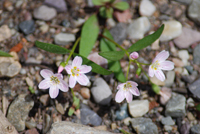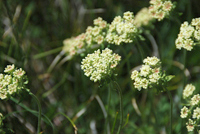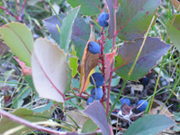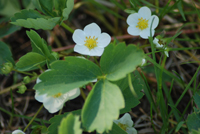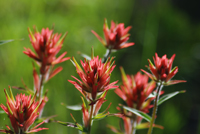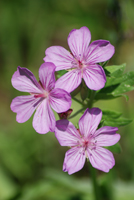During the 40 Days to 40 Years Blog, we have been describing different hikes that are accessed from the John D. Rockefeller, Jr. Memorial Parkway. After today's blog post, perhaps you will take a closer look at the many wildflower species you can see along the trails, some of which are described below.
-DL
NPS Photo/D. Lehle
Springbeauty (Claytonia lanceolata; Portulacaceae Family)
"Springbeauties are widespread throughout both parks and are among the first flowers to follow the retreating snow banks. Several stems grow from a tuberous underground stem. Each of these stems has two basal leaves which are rather fleshy. Flower color varies from white to pink, and in the whiter forms pinkish veins add emphasis to the notched petals. Some plants are found even above 9000 feet in August. The tuberous stems were dug by the Indians and eaten as we would eat potatoes". (1)
NPS Photo/D. Lehle
Sulphur buckwheat (Eriogonum umbellatum; Polygonaceae Family)
"Also known as Sulfurflower, this plant is especially showy in the rocky, sagebrush flats. The sulfur-yellow blossoms are in an umbrella-like cluster at the top of a 10 to 12 inch flowering stalk, while the numerous leaves grow very near to the ground and accumulate bits of organic matter which eventually become part of the soil. The flowering period extends from mid-June to early August". (1)
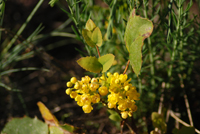
NPS Photo/D. Lehle; NPS Photo
Oregon grape/creeping barberry (Mahonia repens; Berberidaceae Family)
"Creeping barberry; Oregon grape is a common, low shrub less than 18 inches high. Every spring dense clusters of yellow flowers brighten the appearance of prickly evergreen leaves. By August the plant have produced rather sparse clusters of grape-like fruit. These berries are pale green when they first appear and slowly ripen to bluish-purple. Along with the ripening of the fruit, the leaves turn beautiful shades of red or purple." (1)
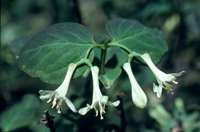
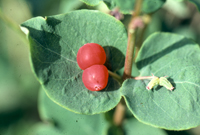
NPS Photos/Cooper
Utah honeysuckle (Lonicera utahensis; Caprifoliaceae Family)
"Known also as Red Twinberry, this shrub of the lodgepole pine forest varies from 2 to 5 feet high. In June the paired, yellow flowers are a delight to behold. The five petals are united into a funnel-shaped tube which is slightly swollen at the base. The fruits are attached to the axil of the leaf by short, 1 inch pedicels. The fruits are eaten by birds and chipmunks, and while some reports tell of a poisonous substance being present, there is little danger to children because the fruits are not palatable." (1)
NPS Photo/D. Lehle
Woodland strawberry (Fragaria vesca; Rosaceae Family)
"This familiar wild flower and fruit inhabits the lodgepole pine forest. Even though it lacks erect stems, it produces horizontal runners which, in turn, form new plants at their terminus. Such vegetative reproduction is very efficient. Each flower bears 5 green sepals, 5 rounded petals, and numerous stamens. Many of the wild strawberries have a more delicious flavor than the cultivated varieties. A variety of wildlife enjoys the berries." (1)
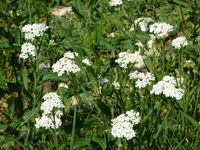
NPS Photo/K. Chiasson
Common yarrow (Achillea millefolium; Asteraceae family)
"Before it blooms, this wild flower is sometimes mistaken for a fern because of its much divided leaves. The composite flowering heads are small and numerous with both ray and disk flowers. The scientific name Achillea is after Achilles who is supposed to have made an ointment from a relative of Yarrow to heal his wounded warriors after the siege of Troy. The Indians pulverized the plant and applied it to cuts, bruises, and wounds. High in the canyons above 9000 feet this plant may be only 6 to 8 inches tall, but in the valleys, it may reach 2 feet." (1)
NPS Photo/D. Lehle
Paintbrush (Castilleja genus; Scrophulariaceae Family)
"The actual flowers of the plant are narrow, tubular, and greenish-yellow. The vivid scarlet of the leafy bracts provide the color of the most common species, and yet there are several species in the park whose bracts are white, yellow, orange or pink. The plants bloom from mid-June to early September and are found from the Snake River bottom to 11,000 feet. Wyoming has chosen one species as its state flower (C. linariefolia). Identification of the park's 10 to 12 species of Castilleja can be quite frustrating, and it really takes a botanical specialist working with technical details to separate them." (1,2)
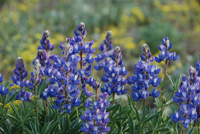
NPS Photo/D. Lehle
Lupine (Lupinus Genus; Fabaceae Family)
"This genus is taxomically very difficult; as a result, botanists have described about 600 species. The problem with this group arises from the fact that many species hybridize, yielding a broad spectrum of intergrading forms. Lupines as a group are easily recognized by typical pea-like flowers, hairy fruit pods, and the palmately compound leaf with 5 to several leaflets at the top of a long petiole. The plants grow in dense colorful clumps in the sagebrush community as well as open pine forests. Lupines benefit the soil because there are nitrogen-fixing bacteria in their root nodules; however, lupines contain lupinine and other related toxic alkaloids which may have serious consequences for livestock." (2)
NPS Photo/D. Lehle
Sticky Geranium (Geranium viscosissimum; Geraniaceae Family)
"Also known in many localities as Cranesbill, this species is a common late spring flower which continues blooming into late August. Found in sagebrush and open woods, the plant grows to a height of 1 or 2 feet. The rose-purple flowers are constructed on a plan of five, i.e., all parts in five or multiples of five. The fruit, which resembles a crane's bill, is unique in its method of seed dispersal; as the capsule ripens, its longitudinal sections split open with such recoiling force that the seeds are catapulted outward from the parent plant for several feet." (1)
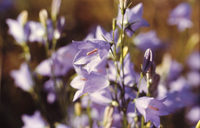
NPS Photo/Kodak
Roundleaf Harebell (Campanula rotundifolia; Campanulaceae family)
"The generic name of this perennial means "little bell," and the specific name, rotundifolia, refers to the roundish, heart-shaped, basal leaves. While the basal leaves wither early, the narrow leaves of the stem remain. A conspicuous feature of the flowers is that, although the buds grow erect, the open blossoms droop or are horizontal, protecting the pollen from rain. Occasionally, white flowers will grace the stems of this circumboreal species. Throughout July and August this delicate herb is frequent in open coniferous forests and along roadside cuts. In rock gardens this plant spreads rapidly by rhizomes." (2)
Sources of quotes:
(1) Shaw, Richard J. and Marion A. Shaw. Plants of Yellowstone and Grand Teton National Parks. Helena: Wheelwright Publishing. 2008.
(2) Shaw, Richard J. Wildflowers of Grand Teton and Yellowstone National Parks. Helena: Wheelwright Publishing. 2004.

